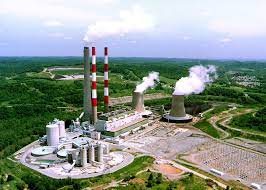From anywhere in Shinnston, or much of Harrison County for that matter, the smokestacks of the Harrison Power Station appear as a sentinel of sorts. They define the skyline, but the real story takes place beneath the superstructure visible over the tree line. Its three coal fired units, all approximately 50 years old, still serve as one of the prides of their company, First Energy.
Harrison Power Station opened operations with Unit One in 1972, Unit two in 1973, and Unit three in 1974. These three units combine to produce almost 2,000 megawatts of activity, which can potentially power two million homes.
West Virginia’s entire population totals between 1.8 and 1.9 million people in total.
Two years ago, the Bureau of Business and Economic Research at West Virginia University’s John Chambers College of Business and Economics shared an estimate of the Harrison Power Station’s economic impact. In Harrison and surrounding counties, the plant boosts the economy by almost $900 million. Approximately half of this impact takes place in the “secondary economy,” or goods and services created to support operations.
Much of this impact comes from its locally sourced coal, which relies on hard working regional West Virginia miners, truck drivers, and others to extract and deliver.
While 230 work directly for the plant, it is estimated that almost 3,200 more work in the secondary economy connected to the plant, earning over $181 million combined. State and local governments receive more that “36 million in tax receipts.
First Energy’s economic impact also comes hand in hand with corporate responsibility. The company invested nearly $1 billion in clean coal production technology, starting almost 30 years ago in 1995. Scrubbers capture 98 percent of sulfur dioxide emissions, while Service Catalytic Reduction systems take 90 percent of nitrogen oxide out of plant emissions.
Upgrades have continued over the years, with the most recent coming last fall. The continual work has elevated Harrison Power Station to the top as one of the nation’s cleanest burning coal fired plants.
The commitment does not stop there.
In recent years, plant managers grew concerned with a rising population of pigeons in and around the plant. Droppings and related problems caused health and safety issues. As Ed Murphy, technical services manager, said in a release, “pigeons are attracted to the warmth and shelter our plant provides.” He explained that humane “attempts to deter them from the area have not been successful long-term.
Murphy installed nesting boxes designed specifically for the use of peregrine falcons, a pigeon predator. As falcons found a new home, the pigeon population moved away.
Also important, almost a decade ago, First Energy initiated a tree trimming program. Last year, Jim Myers, president of West Virginia operations for First Energy, noted that “vegetation management is crucial to our reliability efforts and one of the most effective ways we can reduce the impact of tree-related service interruptions for our customers.”
Since 2014, Mon Power alone has removed vegetation from around 31,000 miles of power lines and trimmed approximately 3.7 million trees. Between the opening of the program and the end of 2022, customer outages dropped by 40 percent. This year will see Mon Power and Potomac Edison (First Energy’s subsidiary in the Potomac Highlands and Eastern Panhandle) clear another 6,800 miles of lines, with 2,400 already completed.
First Energy also takes the lead in philanthropy. As a member of the Harrison County Chamber of Commerce, they support economic growth and development. Last year, the company also steered $60,000 toward worthy causes in Harrison County, such as the Shinnston, Lumberport, and Spelter Volunteer Fire Departments, the Autism Society of West Virginia, the United Way, and more.
Employees also contribute mightily to the region. In the past two years, through the Adopt -a Highway program, they collected more than 5,000 pounds of refuse. They also give time and money to vital organizations, such as Harvest for Hunger, the American red Cross, the Boy Scouts of America, and more.
First Energy was formed in 1997 when Ohio Edison merged with Centerior Energy Corporation. By 2023, First Energy has become one of the nation’s largest investor-owned power companies, serving six million across the Midwest and Mid-Atlantic.


